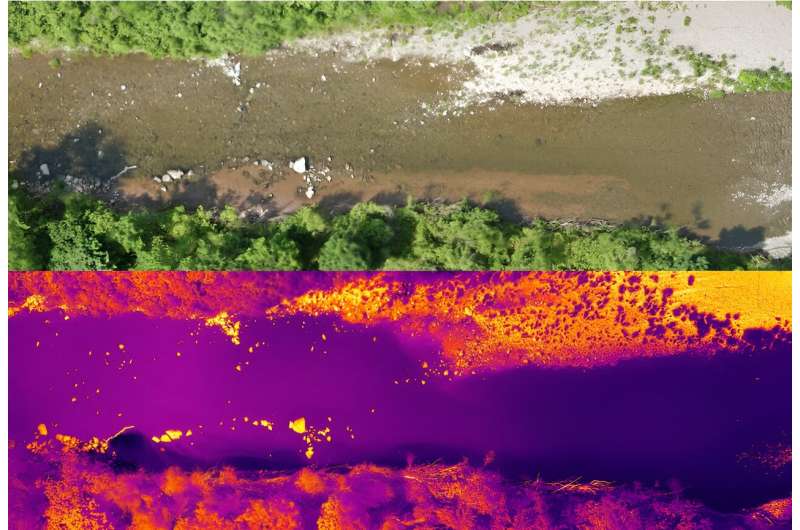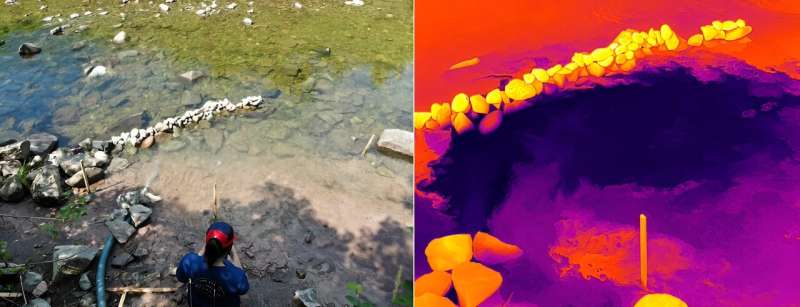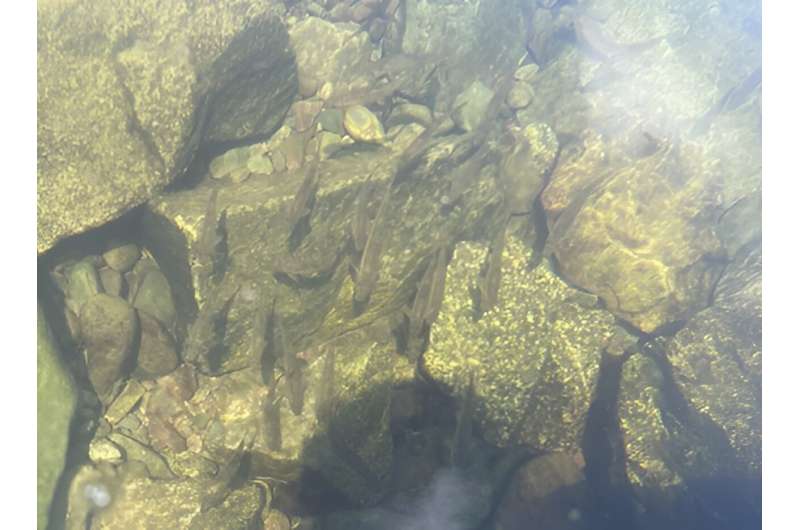This article has been reviewed according to Science X's editorial process and policies. Editors have highlighted the following attributes while ensuring the content's credibility:
fact-checked
trusted source
proofread
Examining the function of salmon cooling stations

You've heard of the salmon run: upon reaching sexual maturity, wild Atlantic salmon, which are born in freshwater rivers but spend most of their adult life in the ocean, swim upstream all the way back to their birthplace to spawn. This remarkable migration—a journey thousands of miles long, against the current—is filled with obstacles, from dams to hop over to hungry bears to dodge.
Climate warming has brought about an additional hurdle for wild Atlantic salmon populations: rising water temperatures. Accustomed to the cold ocean, salmon struggle with warm river temperatures—and the migration typically occurs in the summer, when river temperatures peak. The loss or fragmentation of cold-water habitat has led to declines in Canada's wild Atlantic salmon populations, and within many Nova Scotia watersheds the fish are considered "endangered" under the Canadian Species at Risk Act.
Natural groundwater springs and cold tributaries provide some relief, creating cold areas where salmon can de-stress. These areas are aptly called thermal refuges. Eventually, salmon must journey on, but those breaks are nonetheless beneficial and can mean the difference between life or death for the migrating fish.
Unfortunately, thermal refuges are becoming increasingly rare. The Nova Scotia Salmon Association in collaboration with Dalhousie University just concluded a four-year collaborative science project focused on mapping thermal refuges. "Anglers are our eyes and ears on the ground. They know where fish congregate, and that's most likely a thermal refuge," says Kathryn Smith, a Ph.D. candidate in the Dalhousie Coastal Hydrology Lab group, who was involved with the project through an internship.

With her civil engineering background, Smith decided to step up. Her project aims to proactively engineer cold-water habitats to support salmon in their migration. This type of intervention has never been attempted before, so the researchers were curious whether the fish would even occupy artificially created thermal refuges. Smith is presenting the results of the study this Tuesday at the Geological Society of America's GSA Connects 2023 meeting.
Smith and colleagues devised two approaches to create thermal refuges: one active and one passive. The active strategy consists of pumping cold water (9 °C) into a warm river (30 °C). The cold-water source was a back-up municipal well. The intervention was enacted for two weeks in July and one week in August. Results were closely monitored with thermal probes, drone thermal mapping, and underwater cameras. The thermal plume continued downstream for over 60 m.
The passive approach consisted of digging an underground trench to redirect a meander of the river. While underground, the water would cool away from the sun's rays and dissipate heat into the surrounding wet soil. Upon reinjection into the river, it would lower the average water temperature. In this case, the measured cooling was of only a few degrees for only a few meters downstream. "This is still meaningful," explains Smith. "Cold-water fish species can detect down to 0.1 °C variations."

Indeed, both approaches were successful; underwater wildlife cameras revealed that salmon did congregate in the engineered thermal refuges. There was even some site occupation variability—during a heat wave that occurred during the intervention period, many more fish were spotted in the thermal refuge.
Next, Smith plans to scale up these pilot interventions, helping conservation associations to quantify the impact of the additional thermal refuges on wild Atlantic salmon health and migration success.
More information: Kathryn Smith, Creating groundwater-sourced thermal refuges in rivers to adapt to a warming world, 191: T21. Environmental and Engineering Geology Division II
Provided by Geological Society of America

















